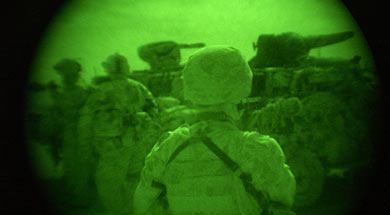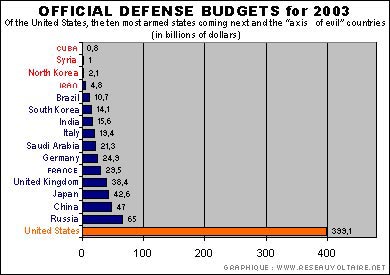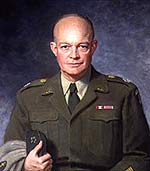In 1961, President Eisenhower said during his last speech in office that “In the councils of government, we must guard against the acquisition of unwarranted influence, whether sought or unsought, by the military-industrial complex.” The expression became widespread as of that moment. But what exactly does “military-industrial complex” mean? In a recently published book, two former arms dealers, Pierre Chavance and Pierre Bouvier, who worked for Thomson armaments, reveal the operations of that industry and how these influence military questions in the economy and in foreign policy of powerful nations today.

The fall of the USSR should have resulted in a reduction of military expenses as of 1991. After more than 40 years of Cold War, during which humanity is believed to have been on the brink of nuclear disaster several times, it seemed that a new way of functioning was possible which would allow people to reap “the ‘socio-economic dividends’ of the return to peace: reconstruction, development, economic growth, enrichment, security.”
US Hegemony Over Military Expenditures
Nevertheless, the economic systems of developed countries, principally the US, are based on their military budgets - which were exceptionally out of proportion during the last years of the Cold War. In 1985, the record amount of military expenses at the world level, effectively reached $1.2 trillion. This includes the sum of military spending by the United States, the USSR and other powers. As of that year, pointed out Pierre Chavance and Pierre Bouvier in Ces armes qui mènent le monde [Weapons That Rule the World] [1], those expenditures diminished little by little, as Mikhail Gorbachov tried to implement a program of reforms in the Soviet Union in the context of relative detente. The decline continued after the fall of the USSR until bottoming out in 1998 at $785 billion. That year, the middle of Bill Clinton’s second term, the United States resumed its armaments program. As Chavance and Bouvier wrote, “at that time, the total world arms spending had not yet begun to grow again to where we are today, dragged down by the US. It should reach around $900 billion in 2003.”
Instead of saying that that cost was “dragged down,” it would be better to say that the rise in world military expenditures was “caused” by the United States. In Europe, all countries continued to reduce their military budgets, except for the United Kingdom, which was aligned with the aggressive foreign policy of Washington. Labour Party Prime Minister Tony Blair often involved British troops in foreign wars, especially Iraq.
The spread of US military hegemony becomes evident when one examines different defense budgets around the world. The following picture is eloquent, as are future year projections. In 2004, military expenses officially recognized in the United States will reach $410 billion. We have demonstrated here that if we add to those expenses the amount spent on military programs administered outside of the Pentagon, the real budget for “American defense” reaches in the true figure of $757 billion [2]. Well beneath that figure is Russia, with $56 billion in 2002 - a budget of six times less. The rest of Europe barely reaches $100 billion, if one excludes the $34.5 billion of the United Kingdom.

It is possible to ask oneself why Washington began to increase military spending at the moment when international threats were particularly weak and at a time when international terrorism still did not seem a consideration. In 1998, Bill Clinton was still heading a Democratic administration. There was no inclination that that administration would take the aggressive path pursued today by the neoconservative Republican administration of George W. Bush. But, in the context of diverse scandals, Bill Clinton lost the support of a part of the Democratic congress and found himself in a minority position. The Republicans forced him to take a position of rearmament, following the war in Kosovo, which he accepted to moderate the economic crisis.
Non-Existing Threats
Who is a threat to the United States? If one adds together the military budgets of the seven so-called “renegade states”-to use the terminology in vogue in Washington- this amounts to $13 billion dollars; this is 25 times less than the US military budget. The conclusion is evident, “there does not exist [presently] any imaginable strategic situation in which US forces can be seen as being threatened or in a situation of inferiority, anywhere.” Much is spoken about the threat that weapons of mass destruction represent for international security. The hypothesis of a terrorist bacteriological or chemical attack that causes large numbers of victims gives a certain degree of credibility to the particularly alarmist speeches of US leaders and their allies, speeches that at the moment have a great deal to do with reality. Since the taking of hostages in Tehran, the annual number of terrorist victims has been estimated at being several hundred, and several thousand in 2001. According to the authors, those are relatively low numbers if they are compared to others. We would find that “the annually number of deaths caused throughout the world by light arms in local guerrilla wars or conflicts is in the order of 500,000 per year (...) and number of people wounded is several times greater.” The authors also mention the annual 23,000 victims of armed murder in the United States. Does there really exist the threat of terrorist groups obtaining advanced military materials? - our inheritance from the Cold War. Putin’s Russia is often mentioned as a place where that type of commerce is done. Nevertheless, no exact evidence of this has been demonstrated. In addition, uranium trafficking through Sudan-which the United States denounced-turned out to be simple manipulation as a part of the psychological war to influence international public opinion.
One can take this type of reasoning even further. Is it possible that the idea of out-of-control arms trade is being used to convince the governments and peoples of American allies that it’s necessary to prepare for that threat by reintroducing the arms race? The truth about the arms market is nevertheless a far cry from what can be read in other publications. As Pierre Chavance and Pierre Bouvier explain, it is an extremely well scrutinized market, although not always transparent and legal. It is framed by rules of conduct that the countries praise themselves for applying, and are made to respect for reasons of national security, so that arms do not fall into the hands of future adversaries. Political power intervenes at various points in the transaction. The most important is the administrative stage. That “consists of obtaining authorization from the supplying government for the arms sale to the particular purchasing country.” Without that authorization, which implies at least an agreement by military authorities, the Ministry of Foreign Relations and the Ministry of Finance, the sale is not possible. The process is complex and rigid. It’s so involved that, according to the authors, “for important orders, that process of authorization can normally extend for a year or two.”
The terrorist guerrilla does not threaten world peace, nor do renegade states. The proliferation of arms of mass destruction is nothing more than a deception. How do we explain then the rearmament of numerous countries, mainly the United States? The authors, who have both worked in the French arms industry (for the Thomson arms company) explain that this has to do with the state of the world market. Contrary to what contemporary economic theories affirm, there is not one liberalized market operating under free competition. On the contrary, “practically one single buyer in each country exists, the Ministry of Defense, [ and ] once this entity chooses the material, the happy one selected turns into the sole supplier, generally according to a system of agreement-by-agreement adjustment [3], from which monopolistic situations are gradually created.” The consequence of this "degenerated” market model is that there is “a natural and uncontrollable confrontation between buyers and salesmen exists, can only be solved within new forms of defense-industry organization and cooperation.”
The US Military-Industrial Complex
This particular form of collaboration found its prototypical realization in the United States. In that country “an operational system of coordination between the federal government and the arms companies” was established and called the “ military-industrial complex.” In the beginning, the influence of industrialists in the economic life of country did not have a military character. It truly begins at the moment in which Franklin D. Roosevelt seeks out a solution to the Great Depression, the same moment at which the aeronautics industry appears. At that time, the average American businessman, who had created competitive industrialist society 20 years earlier, attempted to influence the economic life of the country. For this they needed a pre-existing organization, the National Research Council, “that had been founded on 1917 to coordinate the industrial mobilization for the US’s entry into World War I.” On that occasion, the National Research Council “brought together the nation’s principle physicists, military leaders and leaders of the major science-based companies such as American Telephone & Telegraph (ATT) and General Electric.” This partnership did not rely on the government, whose influence on economic life was energetically criticized.
The Great Depression finally ends - not through the New Deal solution of non-economic problems, but with the authorization of loans guaranteed by Washington for the arming of the warring United Kingdom. Even more, the economy was boosted when the United States entered the war against the Axis forces. This was the same way that the “war on terrorism” allowed George W. Bush to get the country out of the economic crisis in which it was sinking.
The American military-industrial complex took shape in 1947, when President Truman imposed the adoption of the National Security Act on July 26, 1947. That document institutes a secret state apparatus to direct the Cold War. It includes three authorities: the CIA, the Joint Chiefs and the National Security Council (NSC). The latter becomes the “supreme authority of power" that establishes the coordination between the State Department and the Department of Defense. Instead of collaborating, the civil power and military power become confused in the same organization.
That same year, the “public sector system of the National Security States” is set up to organize military support for countries that could potentially fall into the Soviet orbit. According to the authors, "it seems that at that time the Complex was used as an advisor to the NSS on how to use armies and the material perfected by these to gain control over countries that were under military control. The aim of this was “anti-communist decontamination.”

The collaboration between the joint power of the civilian sector, the American military and the armaments industry was reinforced throughout the Cold War period and reached its height during the presidency of General Eisenhower, from 1953 to 1961. He reorganized the National Security Council with the purpose of combining “military policy, international policy and internal security.” Parallel to this, industrialists created the American Security Council (ASC) that organized annual conferences with the Pentagon. In these, no one could differentiate the role of private from that of public policy makers. As the moderator of those conferences, the ASC and the Pentagon resorted to a neutral third party: an academic organization, the Foreign Policy Research Institute (FPRI) led by Professor Robert Strausz-Hupé [4]
. This institute served as model for present day think tanks. At the same time, the Pentagon’s Department of Research and Development (RAND) progressively privatized under the name of the Rand Corporation, to guarantee the technical character of those conferences.
The armaments industry therefore acquired considerable political weight, more than its simple economic importance. Through its evaluation techniques and information, it could indicate to the government strategic threats confronting the country and providing advice on appropriate armaments programs. It suggested-if not determined-foreign policy. Contrary to the Clausewitz theory, war was not the continuation of diplomacy through other means, but that diplomacy and war had become the extension of armaments programs.
One only has to analyze the mammoth budgets of anti-missile defense projects to become convinced that this inevitably emerged due to the confusion of roles in which the salesman becomes advisor and the advisor the salesman. The present situation is another consequence of the previous: “armaments now play the key role in war, and is what better does so with force. Until yesterday, it was war that relied on armaments.” Finally, the influence of the military-industrial complex allows one to understand the state of the American political scene where “a republican government, fanatical over arms and war, allows the Pentagon to dominate the national political scene, and even world politics if this were possible. The Secretary of Defense takes public positions concerning State Department issues, which is easily comprehensible from the moment that the government is thought to jeopardize international policy that reduces foreign relations to the correlation of forces.”
That system produces an ideology that justifies it. As such, in 1957, Samuel Huntington publishes The Soldier and the State [5]. Huntington proceeds from the postulate according to which, in a libertarian economy (which also can be understood as neo-liberal, that is without a state), an invisible hand regulates the free market for the good of all. It would be right, therefore, that political power went to leaders of the most important companies. Nevertheless, the market would not be able to solve the problems of defense. Economic leaders would have to resort, in that respect, to the position of soldiers, who would take on issues of foreign policy and war. That thesis was described as “fascist” by the American press of the time. The work today is going into its thirteenth printing; it is a classic in military academies. As far as Samuel Huntington, he became famous for another theory, the war of civilizations, an outlook adopted today by the present civilian leaders of Pentagon.
[1] Ces armes qui mènent le monde, by Pierre Chavance and Pierre Bouvier, Éditions du Lieu restauré, June 2003.
[2] Cf. “Le vrai budget de la défense US,” Voltaire, January 28, 2004.
[3] In that type of contract, the government chooses certain materials prior to defining the size of orders or negotiating prices.
[4] In the first conferences, Robert Strausz-Hupé hired a brilliant young assistant named Henry Kissinger.
[5] The Soldier and the State. The Theory and Politics of Civil-Military Relations by Samuel Huntington (Harvard University Press, 1957). In essence, the work looks to demonstrate that there exist several civil points of view but a single military outlook. Only at the end of the book does Huntington draw his conclusions on the matter of political organization, conclusions that we have summarized in this article.
 Articles by this author
Articles by this author Send a message
Send a message




















Stay In Touch
Follow us on social networks
Subscribe to weekly newsletter